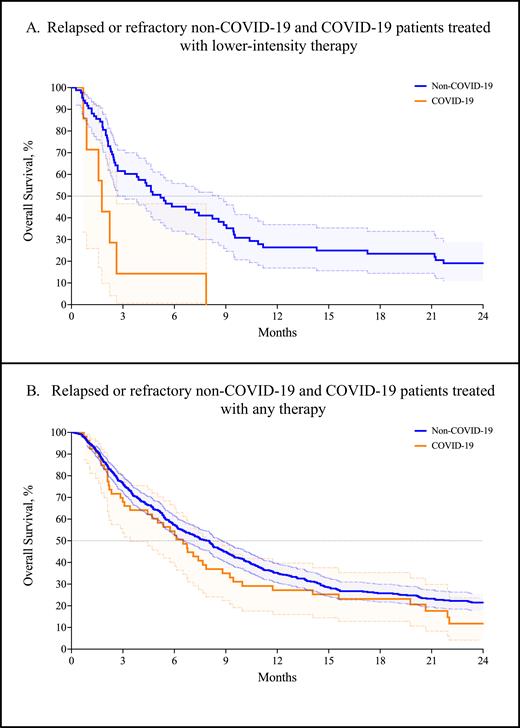Background: The COVID-19 pandemic impacted cancer care nationwide. Challenges with frequent clinic visits for lab draws, administration of multi-agent chemotherapy regimens, and scarcity of supportive blood products disrupted effective health care delivery. The magnitude of these factors on the survival of patients diagnosed with acute myeloid leukemia (AML) during the pandemic is incompletely described.
Methods: We included 627 patients aged ≥18 years with AML treated at VCU Massey Comprehensive Cancer Center from January 1, 2013 to December 31, 2022; we recorded baseline demographics, molecular profiles, induction regimens, and survival data. We defined the pandemic era as March 7, 2020 (coinciding with the first confirmed case in our region) to July 1, 2021 (routine and widespread vaccination available). Survival analyses were performed using the Kaplan-Meier method and compared using the log-rank test. ECOG and Charlson comorbidity index (CCI) scores were compared using the Mann-Whitney test; we used the D'Agostino & Pearson method for normality testing.
Results: The median age of patients who received intensive chemotherapy (7+3, CPX-351, FLAG-IDA, MEC, or HAM) in the COVID-19 pandemic cohort was 60 years (range, 28.5-69.6) vs 58 years (range, 19.6-81.4) for the non-COVID-19 cohort (p = 0.932). The median ECOG performance status in both cohorts was 1 (range, 0-4, p = 0.658). The median Charlson comorbidity index (CCI) score for patients for both groups was 4 (range, 0-9 vs 2-9, p = 0.909).
Patients who were initiated on lower-intensity therapies (e.g., a hypomethylating agent with or without venetoclax) during the COVID-19 pandemic had a median age of 75 (range, 61.9-85.1) years vs 73 (range, 26.1-92.0) years in the non-COVID-19 cohort (p=0.438). The median ECOG performance status for the COVID-19 cohort was 2 (range, 0-3) vs 1 (range, 0-4) for the non-COVID-19 cohort (p=0.005). CCI score for both groups was 6 (range, 4-12 vs 2-14, p=0.789).
We then compared the mOS between the COVID-19 and non-COVID-19 eras for both intensive and non-intensive treatment cohorts. For patients treated with intensive chemotherapy during the pandemic, the mOS was 25.1 months in the COVID-19 cohort vs 18.0 months (p = 0.173) in the non-COVID-19 cohort. For patients treated with non-intensive regimens, mOS was 6.6 months in the COVID-19 cohort vs 6.0 months in the non-COVID-19 cohort (p = 0.963). Patients with relapsed disease who were retreated with intensive chemotherapy during the COVID-19 pandemic had a mOS of 6.5 months compared to 8.2 months (p = 0.094) in the non-COVID-19 cohort. Relapsed patients in the lower-intensity COVID-19 cohort had a significantly shorter mOS of 1.8 months compared to 5.2 months in the non-COVID-19 cohort (p = 0.005).
Regardless of therapy, the mOS was shorter in the COVID-19 cohort at 11.0 months compared to 13.4 months in the non-COVID-19 cohort (p = 0.191). Relapsed or refractory patients in the COVID-19 cohort had significantly shorter mOS at 5.8 months compared to 8.0 months in the non-COVID-19 cohort (p = 0.019).
Discussion: The median overall survival appears shorter for patients diagnosed with AML during the COVID-19 pandemic. Patients with relapsed or refractory AML appeared to have significantly worse overall survival during the COVID-19 pandemic, particularly with lower-intensity therapies. Patients treated with less-intensive regimens are generally older with increased frailty, raising concern for lack of physiologic reserve. These results convey a lesson in preparation for future healthcare crises.
Disclosures
Maher:Bristol Myers Squibb: Membership on an entity's Board of Directors or advisory committees; Sobi (Doptelet): Speakers Bureau.


